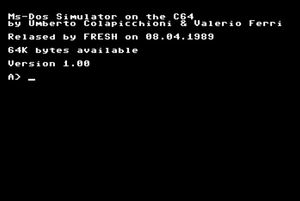DOS

A Disk Operating System (short: DOS) provides a software interface to magnetic disk-based storage. Commodore's Disk Operating System is built into the intelligent peripheral disk drive itself as firmware in ROM chips onboard.
Commodore DOS conforms to a standardized text command interface between the host computer and the intelligent peripheral.
The commands and feature set supported by the DOS is dependent upon the model of disk drive attached to the host computer.
DOS general[edit | edit source]
Overview of a few DOS systems of different old home computer systems:
- CP/M (since 1975)
- TRS-DOS (1978)
- Commodore DOS/CBM-DOS (since 1979)
- Apple DOS (July 1978)
- Atari DOS (1979)
- AmigaDOS (1985)
- IBM-PC compatible DOS (since ca. 1980)
These DOS version and systems aren't compatible together!
Commodore DOS[edit | edit source]
CBM-DOS Versions[edit | edit source]
- CBM2040 with CBM-DOS 1 (spring 1979)
- CBM3040 with CBM-DOS 1.2 (autumn 1979)
- CBM3040/CBM4040 with CBM-DOS 2.0 (1980)
- CBM4040 with CBM-DOS 2.1 (summer 1981)
- CBM-DOS 2.5 (1982)
- VC-1540/1541/1551, CBM2031/4031 with CBM-DOS 2.6 (since 1982)
- SFD-1001 mit CBM-DOS 2.7 (since 1983)
- 1570/1571 and CBM8020/9060/9090 with CBM-DOS 3.0 (since 1985)
- Inside 1571 in C128D/DCR with CBM-DOS 3.1 (since 1986)
- 1581 with CBM-DOS 10 (since 1986)
Notice: Later models of the same disk drive type can have higher CBM-DOS versions!
PC compatibles DOS[edit | edit source]
Overview of differents DOS for the PC from different software producers:
- MS-DOS from Microsoft
- PC-DOS from IBM (temporary developed by Microsoft)
- DR-DOS from Digital Research (to buy out by Novell)
- Novell DOS from Novell (a further development of DR-DOS)
- Caldera Open DOS (earlier: Novell DOS)
- PTS-DOS
- FreeDOS (a open-free DOS clone)
In the years 1986 until 1988 a Italian programming team developed a MS-DOS Simulator, which are simulated important commands of the COMMAND.COM.
Links[edit | edit source]
| Wikipedia: Disk_Operating_System |
| Wikipedia: Commodore_DOS |
| Wikipedia: TRS-DOS |
| Wikipedia: MFM |